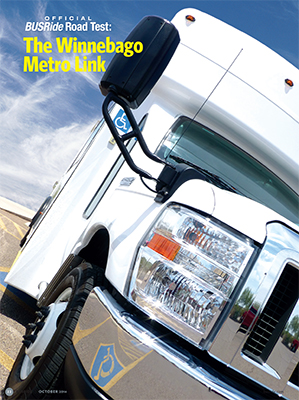
Winnebago has entered public transit with a cutaway that tests quiet and responsive
By David Hubbard
All considered, the Metro Link bus is hardly a stretch for Winnebago, Forest City, IA, the premier builder of body-on-chassis RVs and motorhomes. In full production this past year and now making its way into the small and midsize market, the inception for this new cutaway vehicle was born from the 2008 recession when the company began kicking ideas around for further diversification.
—————————————————————————————————————————————
YOU MIGHT ALSO LIKE:
—————————————————————————————————————————————
Winnebago says it had only to redirect its design and engineering capabilities to reflect its research findings in the small and midsize bus market; noting that its entrance into public transit was an initiative it did not take lightly.
“We had explored opportunities in other relevant areas, such as towable trailers and fifth-wheels, and eventually acquired an existing company with an acceptable product line, which we adapted and refined to enter that market,” says Winnebago Director of Specialty Vehicles Jamie Sorenson. “Similarly, our company looked at OEMs already manufacturing cutaway buses, but ultimately concluded the existing products did not differentiate enough from one to the next to warrant an investment.”
He says through further market research, Winnebago chose to move forward on its own and develop a proprietary product.
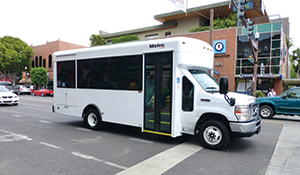
Winnebago takes its time
“The market research Winnebago conducted was a long and arduous process,” says Scott Loges, business unit president, Metro Worldwide, Clear Lake, IA, the North American distributor for the Winnebago Metro Link in commercial bus markets. “There were never any spur of the moment decisions. In fact, the company invested a good three years in research and development for an entirely new bus with features that would immediately differentiate it from the competition.”
Drawing on its 20-year relationship with Metro Worldwide as its chassis supplier, Winnebago entered into a partnership, believing Metro Worldwide is in a better position to market, sell and deliver the Metro Link than traditional RV dealerships. Sorenson says this move also eliminates the need for a separate sales department within the company.
Loges says the engineers studied the typically problematic aspects of small and midsize buses, and drew their design of the Metro Link from conversations with transit operators in northern Iowa and southern Minnesota.
“Winnebago’s concept for this bus certainly encompasses both public and private bus transportation,” Loges says. “However, in this region of the country, the public agencies were simply more accessible as Winnebago conducted its initial research.”
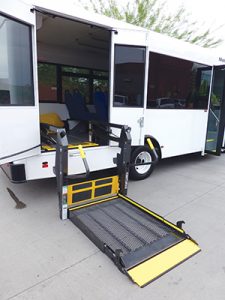
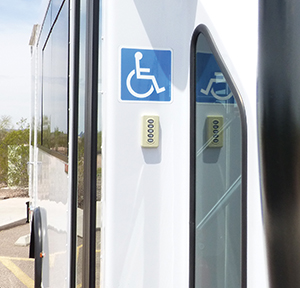
The Official BUSRide Road Test
BUSRide prevailed upon Donnell Adams, a veteran driver for Valley Metro Regional Transit Authority, Phoenix, AZ, contracted through First Transit, to take the Metro Link through a road test from the perspective of a third party.
“I used to own a couple of RVs, so when I heard I was going to be test driving a Winnebago bus, I was very surprised,” Adams says. “My first impression of the Metro Link was of a clean, good looking vehicle.”
Adams joined Valley Metro eight years ago, and now serves as director of Driver Safety and Training.
With nine passengers on board from Winnebago, Valley Metro and BUSRide, he elected to put the Metro Link through the paces on one of the established trolley routes through Tempe and Scottsdale, and on a few additional sections of freeway. Adams says he viewed its performance through his lens of safety, training and passenger comfort, offering his comments afterward at the City of Tempe East Valley Bus Operations Maintenance Facility.
“The Metro Link transit bus is very quiet and the seating is very comfortable,” he says. “But this is Winnebago, and I guess that comes from being in the RV business. Driving a bus as long as I have, and training others to drive a bus, these are the qualities I looked for right off the bat.”
Loges notes that as the RV industry leader, Winnebago realized it would be building a vehicle to operate in commercial applications unlike any of its other products.
“On average, RV owners put 8,000 miles a year on their vehicles,” Loges says. “In the bus business, an operator can easily log up to 8,000 miles in a month.”
Not the typical body-on-chassis construction, Winnebago builds the Metro Link to withstand the rigors transit and shuttle buses encounter on a daily basis.
Adams turned into an empty parking lot and put the bus through a few impromptu maneuvers, executing several tight turning circles in both directions and running slalom around light poles.
“Driving like this does not crop up on the regular route,” he says. “But it does tell me the suspension on this bus is great. The turning radius on this bus is definitely tighter than buses I am used to driving; and that’s fine because sometimes we get into in situations where we need to negotiate tight turns to avoid an accident.”
On a quiet side street, BUSRide invited Adams to put the Metro Link through several sudden controlled stops.
“The controlled stop is a good exercise,” he says. “The stopping distance was very good. I wasn’t expecting that. I don’t know if it is in the manufacturing or the chassis, but when we make a controlled stop with the buses we drive, the entire bus shifts and jerks back. That did not happen on this bus. It came to a very smooth stop in spite of the short distance.”
Winnebago says this has to do with its more rigid frame and mounting techniques, and a more balanced center of gravity.
“I was waiting for that typical shift, but, instead, at the speed we were going it was a very different feel,” Adams says. “The entire body didn’t move forward, which I was anticipating a bit. I am a good driver, I can make a controlled stop with the brakes, but I can’t keep the body from shifting.”
On the freeway run, Adams was satisfied with the acceleration.
“This is a bus that would normally be carrying passengers, so when it comes to acceleration, we aren’t running the Indy 500,” he says. “But we still need that extra pickup to move in and out of traffic safely, where acceleration and deceleration play a big part. This bus has plenty of pep.”
The proprietary solid steel roll cage and floor structure fit precisely onto the chassis. Winnebago welds the steel cage and floor structure directly to the chassis. This is the same body-on-chassis mounting system as for its C-body motorhomes, which it says gives the Metro Link more rigidity.
The roll cage is 1.5-inch square tubular roll-cage sections welded at the floor line and at the apex of the roof. The floor system employs stronger 2 x 4-inch box tube steel of a thicker gauge in place of the more the more common 2 x 3-inch C-channel.
“This construction is unique to the Metro Link in that we have eliminated the rubber puck isolators that are so common,” Sorenson says. “Our testing of the isolators on the first prototype showed they are actually a substandard design feature that creates weak links in the body.”
He says the rubber expands and contracts as the body moves around, while right above the rubber isolators the metal is flexing and becoming fatigued. With the welded structure, the box does not roll and flex separately from the chassis.
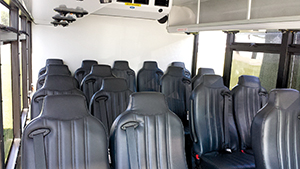
Winnebago says its true one-piece molded fiberglass roof on the Metro Link is another major development, as opposed to a one-piece center section with front and rear caps.
“The entire bus structure from the ground up functions as a unified structure,” Loges says. “This eliminates all cavitation in the walls and strengthens the vehicle. Applying the sidewall online eliminates additional holes on the exterior of the bus.”
The company says the net result of new componentry, design and engineering is a much quieter bus.
“Our first objective was not necessarily to design and build a quieter bus,” Sorenson says. “But it is turning out to be a standout quality for the Metro Link.”
To substantiate the claim, Winnebago points to the Altoona test findings, which show a statistically lower decibel rating for ambient noise than other OEMs.
More than comfort, Adams believes a quiet bus is a safer bus.
“The driver deals with noise from all directions,” he says. “Passengers talking, radio traffic from the base, excess rattling throughout the bus, air coming through the windows — all that noise is a distraction for the driver and a nuisance for the passengers. It is exhausting, and wears everyone out. A distracted and irritable driver leaves room for mistakes, poor judgment and accidents.”
He says the quieted ride on the Metro Link would make it easier for the driver to pay closer attention to his driving, accommodate the passengers and communicate with dispatch.
According to Loges, the patent-pending frameless-like window design with large glass panels nearly flush to the sidewall helps eliminate excessive wind noise.
“I think passengers are going to really appreciate the more expansive views,” Adams says. “As for me, these windows add to the quietness. I didn’t hear air from leaking in like I do on other buses.”
The lighting also caught Adams’ attention, as well as the security interlock at the door.
“I especially like the LED lighting on this bus —again for safety,” he says. “We have buses running until 10:00 or 11:00 at night. They are very dark and cause for hazardous and dangerous situations.”
He says the secure interlock is important as Valley Metro buses have to stay running during stops.
“We cannot pull into the transit center and turn off the engine,” Adams says. “Given the hot temperatures in Phoenix for most of the year, passengers want to sit in the bus with the AC running. This interlock is more important than it may first appear. We have them for safety and use them to prevent theft.”
Winnebago tests in-house
Winnebago prides itself on its in-house testing capabilities, which include a test track similar to Altoona with built-in obstacles and a MTS road simulator to test various components under real life driving conditions.
“We ran the Metro Link prototype on the hydraulic shaker for 573 hours, which our test engineers equate to 210,000 miles,” Sorenson says, “We essentially put this bus through a seven-year, 200,000-mile Altoona test before it ever went to Altoona.”
According to Sorenson, Winnebago integrated its testing into the early design phase of the Metro Link.
“Where a pull test failed early on, engineers were able to collect that data and respond immediately with a different solution,” he says. “Moving the pull test so far forward in the process and testing as we go has proven more productive than testing at the end of the build.”
As an example of this earlier testing, the company discovered that in bolting the floor-track and sidewall seat track into place, the heads of the fasteners were ripping off during the pull test. The solution was to weld rather than bolt the floor-track and sidewall seat track into place.
“This system makes the Metro Link very flexible with floor plan configurations,” Sorenson says. “We standardize some positions of the sub steel in the framework to allow greater flexibility in positioning the floor track to accommodate both perimeter and forward seating.”
The Metro Link is currently available in 24-foot and 28-foot lengths. Winnebago builds only on Ford 450 and 350 chassis thus far, but says a model on a GM chassis that will provide the option for diesel is in development and will be available for production by the end of the year.
